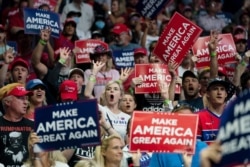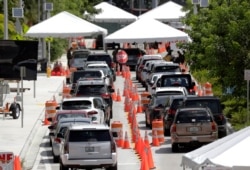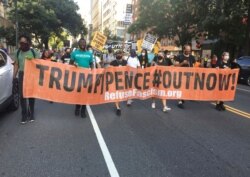Real estate tycoon and television reality show host Donald Trump was viewed by many voters as something of a political unknown as he sought the presidency in 2016 — but one worth taking a chance on, even as numerous pundits and pollsters thought he surely would lose the national election.
But Trump won an upset victory over Democrat Hillary Clinton, and now he’s back for another go-round. As the sitting president, he is accepting the Republican Party’s nomination for a second term with a speech Thursday night at the White House. A crescendo of fireworks on the National Mall will herald the moment.
Trump has a 3½-year track record, including thousands of daily, often acerbic Twitter remarks targeting political foes and making policy on the fly.
But supporters have extolled him as bold and innovative, crediting him with restoring an “America First” credo across the globe, while moving toward a less regulated state of life within the U.S. by signing dozens of executive orders limiting governmental oversight and control.
The Trump administration claims successes over the last 3 ½ years — a massive tax cut benefiting American businesses and individuals, a partial trade agreement with China, construction of part of a wall along the Mexican border to curb illegal migration (although Mexico didn’t pay for it as Trump claimed it would), and new diplomatic relations between Israel and one of its neighbors, the United Arab Emirates.
The Nov. 3 election is now 10 weeks away, a contest between Trump and his Democratic opponent, former Vice President Joe Biden. There have been notable events in Trump’s presidency — his successful appointment of two conservative jurists to the Supreme Court, a once booming U.S. economy with a five-decade low unemployment rate, and his impeachment and acquittal on allegations he sought help from Ukraine to stain Biden’s run for the presidency.
But polls now show the state of the economy, devastated by the sweep of the coronavirus across the country, and worries about the pandemic itself are two of the most immediate concerns for U.S. voters. The coronavirus pandemic originated in China but since March has killed a world-leading 180,000 people in the United States and infected more than 5.8 million people, according to Johns Hopkins University data.
Asked recently to assess the U.S. death toll, Trump replied, “It is what it is.”
Handling COVID-19
Polls show the U.S. public disapproves of Trump’s handling of the pandemic. The Associated Press-NORC Center for Public Affairs Research this week said approval of his coronavirus performance has dropped sharply, to 31%, as the Republicans gathered for their party’s four-night convention.
Republican stalwarts have attempted to portray him as decisive in handling the coronavirus, citing him for curbing entry of travelers from China in early 2020 after the initial virus outbreak in Wuhan.
But Trump voiced constant skepticism of the virus’ lethality and its effect on the U.S.
In a clip from a television interview in late February that is often replayed on news programs, Trump predicted the coronavirus was “going to disappear.”
“One day, it's like a miracle, it will disappear," he said.
But with the U.S. seemingly initially unprepared to deal with the public health crisis, Americans were soon also engulfed in an economic disaster caused by the raging virus. More than 50 million workers lost their jobs — more than a quarter of the U.S. labor force — as state governors ordered businesses closed to contain the pandemic.
Schools and universities ended classroom instruction in favor of online learning from home. Professional and collegiate sports leagues delayed or ended their seasons, while hospitals postponed elective surgeries, and restaurants resorted to curbside food pickups.
For weeks, Trump staged daily news briefings about the coronavirus but often downplayed its severity. He called for an accelerated vaccine, as health experts cautioned that such a preventative would not be available until the end of the year or early 2021.
For a while, Trump hailed the anti-malarial drug hydroxychloroquine as a cure for the coronavirus, and said he took daily doses. But health studies in several countries said the drug was ineffective in treating the virus. While health experts urged Americans to wear face masks to limit the spread of the virus, Trump offered conflicting messages about their effectiveness and said wearing one was not for him, although he more recently has occasionally put one on in public.
Health experts are predicting that tens of thousands more Americans will die of COVID-19 in the coming months. The number of new cases has currently ebbed but has not abated. The U.S. jobless rate peaked at 14.7% in April and dropped to 10.2% in July. Experts say the partial recovery has weakened. Trump says better days are ahead for the economy in the second half of 2020 and into 2021.
Protests sweep the nation
As the coronavirus silently spread to all 50 U.S. states, Trump was also confronted with angry and sometimes violent protests that swept the country following the May 25 death in Minneapolis, Minnesota, of George Floyd, an African American man who was pinned face down on a street by a white police officer pressing his knee on Floyd’s neck for more than eight minutes.
Trump expressed support for peaceful protesters but adopted a tough law-and-order stance against violent protesters. His critics and some of his supporters condemned the actions of federal and local law enforcement officials who forcefully cleared demonstrators from a park across from the White House on June 1 as Trump walked across a street and stood in front of a church, holding a Bible aloft.
Uncertain future
With the turn of events in the first half of 2020, Trump’s political fate is now uncertain. Numerous national polls show him trailing Biden by an average of 7.6 percentage points, according to an aggregation of polls by the RealClearPolitics website.
Only two U.S. presidents have lost bids for reelection in the past four decades. Trump supporters noted he also trailed in polling ahead of the 2016 election before he defeated Clinton, the country’s former top diplomat.
Trump’s reelection campaign slogan is “Keep America Great,” a variation of “Make America Great Again” from 2016.
Now, he says he will restore the U.S. economy — the world’s largest — if voters agree to keep him in the White House.
“We did it once, and now we will do it again,” Trump promised. “And this time, we’re going to finish the job.”









